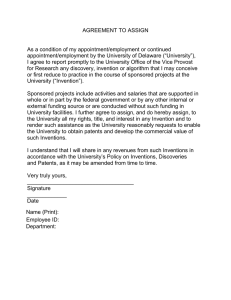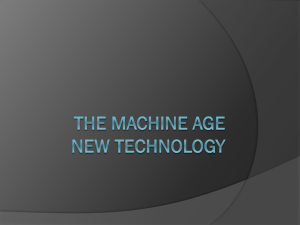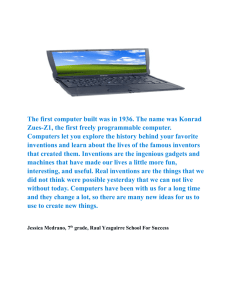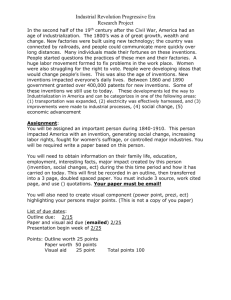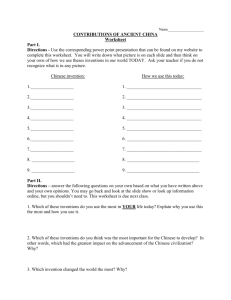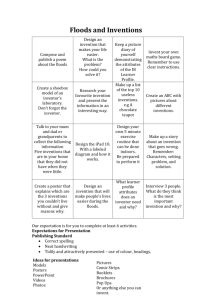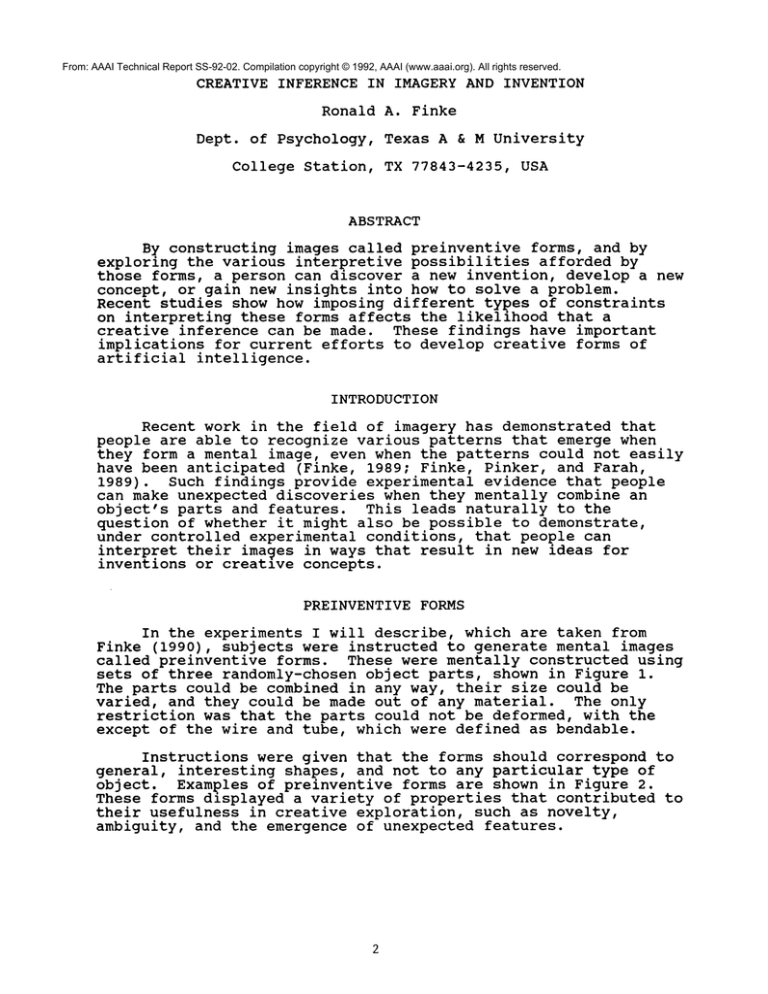
From: AAAI Technical Report SS-92-02. Compilation copyright © 1992, AAAI (www.aaai.org). All rights reserved.
CREATIVE
INFERENCE
IN
Ronald
Dept.
of
Psychology,
College
Station,
IMAGERY
A.
INVENTION
Finke
Texas
TX
AND
A & M University
77843-4235,
USA
ABSTRACT
By constructing
images called
preinventive
forms, and by
exploring
the various
interpretive
possibilities
afforded
by
those forms, a person can discover
a new invention,
develop
a new
concept,
or gain new insights
into how to solve a problem.
Recent
studies
show how imposing
different
types of constraints
on interpreting
these forms affects
the likelihood
that a
creative
inference
can be made. These findings
have important
implications
for current
efforts
to develop
creative
forms of
artificial
intelligence.
INTRODUCTION
Recent
work in the field of imagery
has demonstrated
that
people
are able to recognize
various
patterns
that emerge when
they form a mental
image, even when the patterns
could not easily
have been anticipated
(Finke,
1989; Finke,
Pinker,
and Farah,
1989).
Such findings
provide
experimental
evidence
that people
can make unexpected
discoveries
when they mentally
combine
an
object’s
parts and features.
This leads naturally
to the
question
of whether
it might also be possible
to demonstrate,
under controlled
experimental
conditions,
that people
can
interpret
their images
in ways that result in new ideas for
inventions
or creative
concepts.
PREINVENTIVE
FORMS
In the experiments
I will describe,
which are taken from
Finke (1990),
subjects
were instructed
to generate
mental
images
called
preinventive
forms.
These were mentally
constructed
using
sets of three randomly-chosen
object parts,
shown in Figure i.
The parts could be combined
in any way, their size could be
varied,
and they could be made out of any material.
The only
restriction
was that the parts could not be deformed,
with the
except of the wire and tube, which were defined
as bendable.
Instructions
were given that the forms should
correspond
to
general,
interesting
shapes,
and not to any particular
type of
object.
Examples
of preinventive
forms are shown in Figure
2.
These forms displayed
a variety
of properties
that contributed
to
their usefulness
in creative
exploration,
such as novelty,
ambiguity,
and the emergence
of unexpected
features.
eo
Figure
i.
Object
Figure
parts
2.
0
used
Examples
to generate
Preinventive
of Preinventive
Forms.
Forms.
CREATIVE
INVENTIONS
AND
CONCEPTS
The subjects
were instructed
to interpret
their preinventive
forms as representing
some kind of practical
object or device,
corresponding
to one of eight general
object
categories,
such as
"furniture,"
"tools and utensils,"
and "toys and games."
The
experiments
varied whether
the categories
could be chosen by the
subjects,
were specified
randomly
in advance,
or were specified
only after the subjects
had completed
their preinventive
forms.
The resulting
inventions
were rated on originality
and
practicality,
and these ratings
were used to classify
the objects
as creative
inventions.
The greatest
number of creative
inventions
were obtained
when the subjects
did not know what the interpretive
category
would be at the time they generated
their preinventive
forms.
This suggests
that, in trying to use imagery
to come up with a
creative
idea, it may sometimes
be better to suspend
interpretive
knowledge
until after the image is formed.
Other findings
showed
that the interpretive
categorles
should not be restricted
too
narrowly;
when the particular
type of object
was restricted,
for
example,
fewer creative
inventions
were obtained
than when the
general
object category
or its function
were restricted.
Even though
they were given only one minute to generate
and
interpret
their forms, the subjects
were able to discover
a
creatlve
invention
on an average
of one out of every six trials,
in the case where the general
object category
was specified
after
the preinventive
forms were generated.
When extended
time was
provided
to explore
the preinventive
forms, it was possible
to
discover
a creative
invention
of some kind on virtually
every
trial.
Additional
studies
showed
that the same preinventive
form
could be interpreted
as representing
different
inventions
across
the various
categories,
illustrating
the range of possible
interpretations
that the forms could inspire.
Extensions
of these experiments
have demonstrated
that
preinventive
forms can also be interpreted
in more abstract
ways;
for example,
as visual
metaphors
representing
creative
concepts.
Subjects
were given general
topical
categories
such as "medicine"
and "architecture,"
and were instructed
to interpret
their
preinventive
forms as representing
an abstract
idea or concept
pertaining
to the category.
Although
this was more difficult
than the creative
invention
task, the subjects
were still able to
discover
creative
interpretations,
and generated
a creative
concept
on about one out of every 12 trials.
These experiments
show that it is possible
to investigate,
empirically,
some of the cognitive
processes
that are actually
used in creative
discovery,
and to identify
the kinds of
inferential
constraints
that maximize
the likelihood
of achieving
a creative
insight.
IMPLICATIONS
FOR
ARTIFICIAL
INTELLIGENCE
These findings
have important
implications
for efforts
to
develop
creative
forms of artificial
zntelligence.
They suggest,
for example,
that it would be possible
to develop
computers
that
could generate
novel types of preinventive
forms,
recognize
when
a preinventive
form would correspond
to a useful
object or would
serve as a useful analogy,
and provide
novel conceptual
interpretations
of the forms.
In addition,
because
the same
types of processes
would apply across many different
domains,
this work could lead to the development
of artificial
intelligence
that would be capable
of more general
and universal
forms of creative
inference.
One example
of a general
model that can describe
creative
inference
using preinventive
forms is the Geneplore
model,
proposed
by Finke,
Ward, and Smith (in press).
The structure
this model is illustrated
in Figure
3. The model makes a
general
distinction
between
generative
processes,
such as mental
synthesis,
and exploratory
processes,
such as functional
and
conceptual
inference.
The creative
process
begins
by generating
a preinventive
structure,
which may or may not be conceived
with
some particular
goal in mind. Exploratory
processes
are then
applied
to the structure,
which are guided by various
constraints
restricting
the types of inferences
that can be made. The
resulting
concept
may then be refined
or expanded
by generating
a
modified
preinventive
form and repeating
the Geneplore
cycle.
OF
I
Figure
3.
~
Structure
~l
of
the
EXPLORATION
Geneplore
I
Model.
REFERENCES
Finke,
R. A. (1989).
MA: MIT Press.
Finke,
Principles
of mental
imagery.
Cambridge,
R. A. (1990).
Creative
imagery:
Discoveries
and
inventions
in visualization.
Hillsdale,
NJ: Er bl-6aum.
Finke,
R. A., Pinker,
S., and Farah, M. J. (1989).
Reinterpreting
visual patterns
in mental imagery.
Science,
13, 51-78.
Finke,
Cognitive
R. A., Ward, T. M., and Smith,
S. M. (in press).
Creative
cognition:
Theory,
research,
and applications.
Cambridge,
MA: MIT Press.

